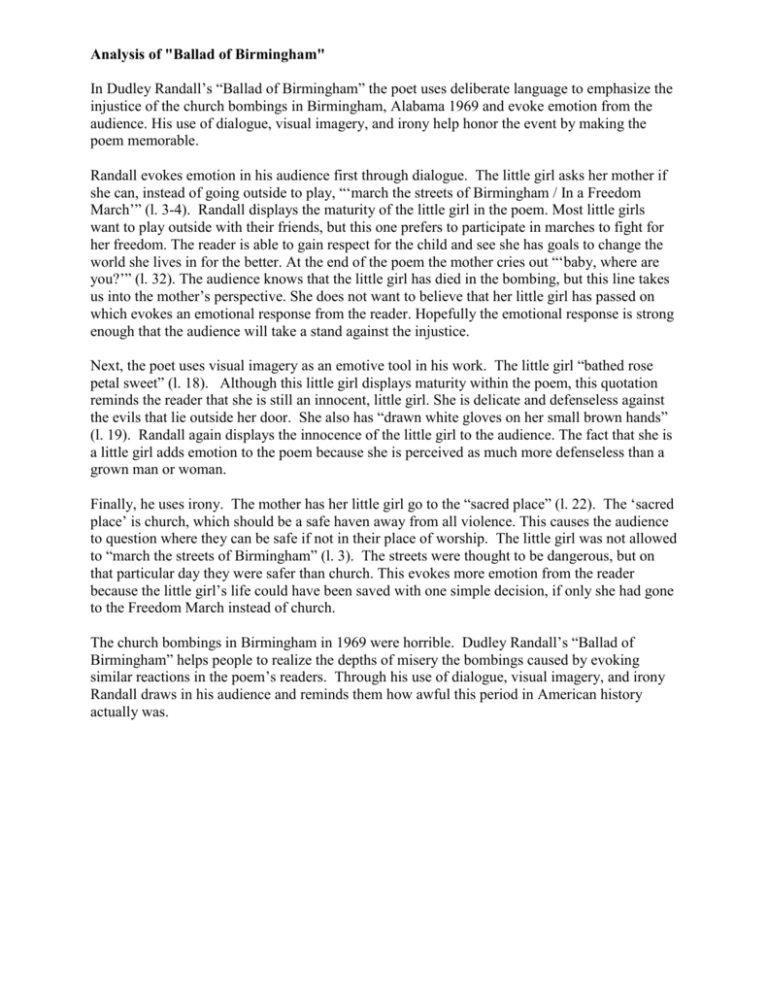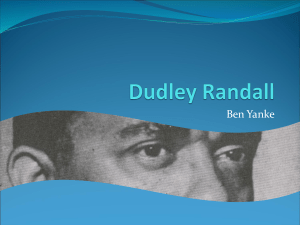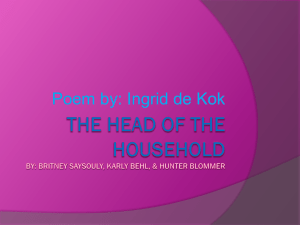Analysis of "Ballad of Birmingham" In Dudley Randall's “Ballad of
advertisement

Analysis of "Ballad of Birmingham" In Dudley Randall’s “Ballad of Birmingham” the poet uses deliberate language to emphasize the injustice of the church bombings in Birmingham, Alabama 1969 and evoke emotion from the audience. His use of dialogue, visual imagery, and irony help honor the event by making the poem memorable. Randall evokes emotion in his audience first through dialogue. The little girl asks her mother if she can, instead of going outside to play, “‘march the streets of Birmingham / In a Freedom March’” (l. 3-4). Randall displays the maturity of the little girl in the poem. Most little girls want to play outside with their friends, but this one prefers to participate in marches to fight for her freedom. The reader is able to gain respect for the child and see she has goals to change the world she lives in for the better. At the end of the poem the mother cries out “‘baby, where are you?’” (l. 32). The audience knows that the little girl has died in the bombing, but this line takes us into the mother’s perspective. She does not want to believe that her little girl has passed on which evokes an emotional response from the reader. Hopefully the emotional response is strong enough that the audience will take a stand against the injustice. Next, the poet uses visual imagery as an emotive tool in his work. The little girl “bathed rose petal sweet” (l. 18). Although this little girl displays maturity within the poem, this quotation reminds the reader that she is still an innocent, little girl. She is delicate and defenseless against the evils that lie outside her door. She also has “drawn white gloves on her small brown hands” (l. 19). Randall again displays the innocence of the little girl to the audience. The fact that she is a little girl adds emotion to the poem because she is perceived as much more defenseless than a grown man or woman. Finally, he uses irony. The mother has her little girl go to the “sacred place” (l. 22). The ‘sacred place’ is church, which should be a safe haven away from all violence. This causes the audience to question where they can be safe if not in their place of worship. The little girl was not allowed to “march the streets of Birmingham” (l. 3). The streets were thought to be dangerous, but on that particular day they were safer than church. This evokes more emotion from the reader because the little girl’s life could have been saved with one simple decision, if only she had gone to the Freedom March instead of church. The church bombings in Birmingham in 1969 were horrible. Dudley Randall’s “Ballad of Birmingham” helps people to realize the depths of misery the bombings caused by evoking similar reactions in the poem’s readers. Through his use of dialogue, visual imagery, and irony Randall draws in his audience and reminds them how awful this period in American history actually was. Analysis of "My Mistress’ Eyes" The three quatrains of the poem employ three different forms of sensory imagery: the first is sights; the second, smells; and the third, sounds. These images are interwoven with other literary devices to paint a more complete picture of the lady. Shakespeare did not rely merely on her looks to characterize his ladylove, but proposes a contrast to the bombast of pedestal poetry. The diction has a simple elegance that suggests the same qualities are exemplified in the woman who he holds in such high esteem. Parallel structure contributes to the meaning of the poem without overwhelming the natural flow of the verses. His smooth transition from single to double line comparisons serves to capture the reader’s attention as the contrasts are further developed. The first two lines begin with similes that use contrasts to describe his lady’s appearance. Her “eyes are nothing like the sun” and coral is redder than her lip color. Then metaphors come into play. The first contrasts her dun colored breasts to white snow, and the next one compares her hair to black wires. The three more metaphors and another simile are developed in the next eight lines. They describe her cheeks as pale, her breath as malodorous, her voice as less than melodious, and her walk to be a solid step on the ground. In the final couplet he uses a simile to show that she is never the less “rare” and the equal to any woman who is falsely praised. This ironic twist reveals the poet’s intentions. What makes this poem distinctive is that the comparisons and contrasts reveal a real woman without idealistic beauty, but with her own natural beauty and self worth. He has created perfection in the poem itself with a symmetrical pattern, precise rising meter and strong, exact, masculine rhyme scheme. There are no extra syllables and no near or slant rhyme. It demonstrates definite statements and supports his confident portrayal. In this manner he has paid her the greatest tribute. It is a true and lasting declaration of love for the real woman without false praise, idealism, or pretentiousness. He creates a sincere declaration of love uncolored by the bias of his emotional attachment. At the same time he has also managed to create humor and hold up for examination other poets who create perfect idols to be worshipped for their ethereal beauty. This suggests a lighthearted parody. Petrarch was noted for his passionate praise of Laura, and he was not alone in this bent. Poets of the period often waxed sentimental over their ladies’ charms. Shakespeare’s verses, therefore, mock the perfect image of love and beauty in women. However, she is nevertheless loved, but for her real self, not for some enhanced illusion. This tendency of Shakespeare to make light of sentimental and romantic ideals is demonstrated in several instances in Romeo and Juliet when Mercutio makes light of Romeo’s infatuation with the fair Rosaline. She was the maiden who possessed such beauty that Romeo believed that no other might ever compare to her. Yet within seconds of seeing Juliet, he had forgotten all about the fair Rosaline. These examples support the attitude and purposefully lighthearted approach with which Shakespeare has portrayed his love and with the honesty in which he has praised the lady who he loves and admires. His lack of false comparisons does not make his love any less real, nor does it detract from the lady’s charm. He states that his love is “rare” and as such special and enduring. He is not using false flattery as a tribute to her; instead he honors her with the act of creating a superb lyric poem that demonstrates his constant and enduring love. He does not endow her with the appearances seen in natural phenomenon, but appreciates her for who and what she is. He shows those attributes to be more lasting than physical attraction alone.






